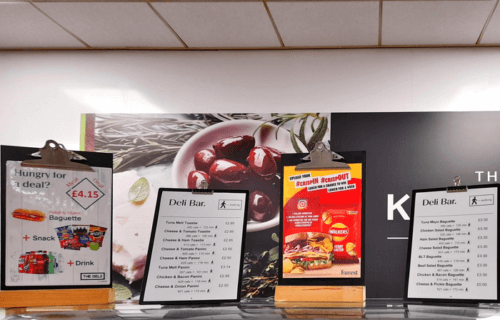CAMBRIDGE, United Kingdom — Food and drink labels showing the amount of exercise you’d need to burn off the calories from your selection don’t change what people choose to eat, a new workplace study reveals.
During a 12-week period in 2021, scientists put physical activity calorie-equivalent (PACE) labels and calorie information alongside all food and drink items in 10 workplace cafeterias. Each one showed how many minutes of walking would be necessary to burn off all the calories of each product.
At the end of the 12 weeks, the team found that there was no significant difference in the amount of calories workers purchased compared to when the labels weren’t there. However, there was a real mixture of results across these cafeterias. One reported a 161-kcal drop per purchase, while another saw a 69-kcal increase with each transaction, and five of the cafeterias had no significant change at all.
The variety of results suggests that these labels aren’t effective and indicates that there are many different factors that influence people’s eating and drinking habits. Since April 2022, calorie labelling is now required on food and drink served out of the home in businesses employing 250 or more people across the United Kingdom.
The research team from the University of Cambridge’s Behavior and Health Research Unit completed two previous studies on the subject. They found that in nine work cafeterias, simple calorie labelling didn’t affect how many calories people bought either.
Too many calories can lead to bigger health issues
Eating too many calories is a key contributor to obesity development. Previous studies have found that home-cooked meals are generally more nutritious than the options workers find at or around their workplace. More than four in 10 adults in the U.S. are overweight or obese, increasing their risk of diseases such as Type 2 diabetes and cancer.
“Although we found that showing the amount of exercise required to burn off calories made little difference to the number of calories purchased – and, we can assume, eaten and drunk – there was considerable variability between cafeterias. This suggests that other factors may have influenced the effectiveness of these labels, such as the type of food sold in the cafeteria or the characteristics of those using them,” says first author Dr. James Reynolds from the School of Psychology at Aston University, who carried out the research while at Cambridge, in a media release.
The number of calories purchased from items that did not feature the PACE labels did not change and the labels made little difference to the revenue for the cafeterias – just a small increase of three cents per transaction.
“This is the largest study in a real world setting to look at the impact of PACE labels on food and drink purchases, examining 250,000 transactions across 10 worksite cafeterias. The findings suggest that PACE labels, contrary to expectations, may have little or no impact on the food people buy in worksite cafeterias,” concludes Professor Dame Theresa Marteau, Director of the Behavior and Health Research Unit at the University of Cambridge.
South West News Service writer Alice Clifford contributed to this report.


Duh. What idiot ever thought that it would?